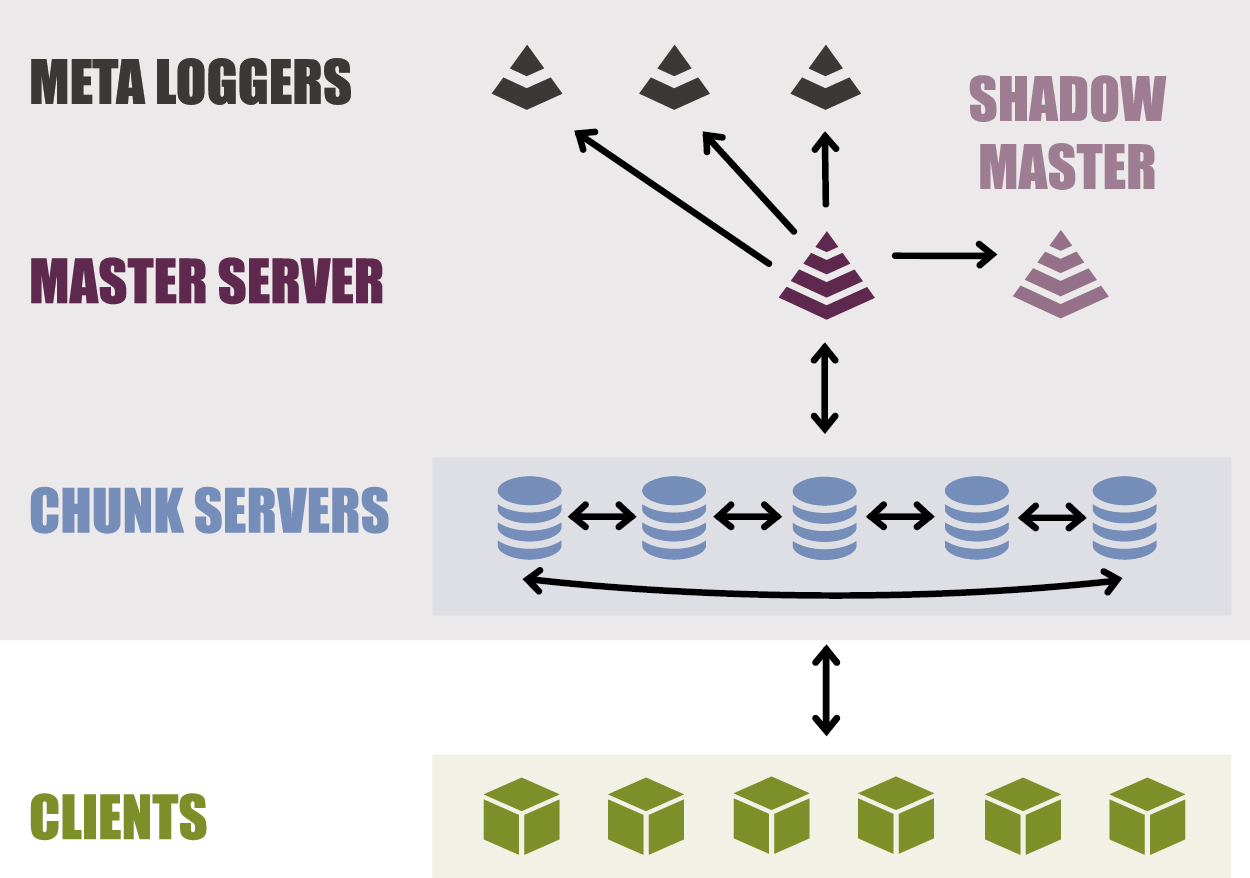This project is a distributed filesystem based on LizardFS http://docs.lizardfs.com wrapped into docker instances.
The client for this filesystem is also a LizardFS Docker instance but includes Haskell code to interact with the filesystem.
The docker configuration files as well as the Lizardfs configuration files were the biggest part of this project, you can find all these scripts in the docker-lizardfs/ forlder.
In this tutorial we will then refer to $MASTER_IP as the IP address of the master node and $RANGE_ESCAPED as the trusted IP server range. Please replace these variables with the actual IPs.
$MASTER_IP = "172.17.0.2" # for example
$RANGE_ESCAPED = "172.17.0.0\\/24" # for exampleFirst you need to launch a master:
docker run -i hugodelval/lizardfs-master /run.sh $RANGE_ESCAPEDTo make sure the service is always up we can launch a master-shadow node, which is ready at any moment to take the role of the master node (by syncing each actions and so on..) :
docker run -i --add-host=mfsmaster:$MASTER_IP hugodelval/lizardfs-shadow /run.sh $RANGE_ESCAPEDThen we need one or several metalogger node(s) which store the metadata for each file/directory (location, size..) in a distributed fashion (information duplicated).
docker run -i --add-host=mfsmaster:$MASTER_IP hugodelval/lizardfs-metalogger bash -c "service lizardfs-metalogger restart && bash"The last step for the sever side of the filesystem is to launch the actual chunkserver nodes, in these nodes will be the actual data (the files). The files will be replicated as well (see later).
docker run -i --add-host=mfsmaster:$MASTER_IP hugodelval/lizardfs-chunkserver bash -c "service lizardfs-chunkserver restart && bash"The first thing you need to do on the client side is to activate the FUSE module https://en.wikipedia.org/wiki/Filesystem_in_Userspace. This is used to mount a filesystem over the network and use it as if it were local. By using FUSE and LizardFS we take advantage of all the power of the Linux Filesystem and we end up having an extremely quicker and robuster filesystem than if we were using an HTTP based distributed filesystem.
To activate FUSE on your Linux, type:
modprobe fuseTo check if it is enabled, type:
lsmod | grep fuseWe are ready to launch the actual client !
docker run -i --cap-add SYS_ADMIN --device /dev/fuse --security-opt apparmor:unconfined --add-host=mfsmaster:$MASTER_IP hugodelval/lizardfs-client-stack /app/scripts/run.shNote that we need to add a Linux capacity to Docker (SYS_ADMIN) as well as the FUSE device and some security options to allow Docker to use FUSE and LizardFS
That's it congratulations!! You now have a fully functional distributed filesystem :) Let's now dig in a bit in the details of the implementation.
Each server can have one or more role (metadata, chunkserver, master and so on..). So it is easy to add a server if this functionnality takes to long (for example if there is a lack of space we can just pop another chunkserver really easily).
Another advantage of the modularity of LizardFS is the cost of the servers, each server can have a specialised hardware depending of its functionnality (ex: big HDD/SSD for the chunkservers).
Tests have been done on LizardFS by huge companies https://www.reddit.com/r/DataHoarder/comments/3igkm2/can_you_please_share_your_experience_with_lizardfs/. They tested it for many days with 10 parallel FIO processes running 24 hours each, every FIO made up of a variable number (10 to 100) threads, on many nodes in parallel. And causing hard resets randomly while doing it. Very few file systems work well doing that. LizardFS was able to work flawlessly even in very hard conditions.
LizardFS exposes only a traditional file system (through FUSE), not an object store and through a layer the CephFS posix layer.
Snapshots are istantaneous, redirect-on-write (like NetApp's WAFL) so only changes are written to disk.
The LizardFS concept of goal is extremely powerful. You can ask for chunks to be placed on a specific kind of disk (for example, one copy on SSD and one on rotational), geographical (one copy here and one in the remote datacenter) and you can set the number of replicas file by file. Goal can be set per file, and changed at any time.
There is a quite easy to use Web interface (cf docker run -d -p 9425:9425 --add-host="mfsmaster:172.17.0.2" hugodelval/lizardfs-cgi), and a good set of command line tools.
Chunks are CRC verified, and periodically rechecked. If change is detected, it gets rewritten transparently from one of the copies.
There is plenty of benchmarks in the web that compare distributed filesystems, one of them (which summurize the whole idea) is located here : http://mrbluecoat.blogspot.ie/2016/02/updated-distributed-file-system.html
From the conclusion of this benchmark we can conclude that GlusterFS and LizardFS are today on the top of the distributed filesystem. LizardFS was much faster than GlusterFS (at the cost of higher CPU usage).
In terms of setup and configuration (which is crucial for maintaining the filesystem during time), GlusterFS was easiest, followed by LizardFS.
From this benchmark we can see that both GlusterFS and LizardFS are both great distributed filesystem and we will be using LizardFS in this project due to the performance of this filesystem.
-
Distributed Transparent File Access
As said previously, LizardFS is efficient and extremely robust, with error recovery and so on.
-
Replication
Go with the robustest of LizardFS, you can easily specify (cf configuration files & Docker) how many copies you want of which files.
-
Caching
Caching is also supported by LizardFS
-
Directory Service
This is done via the metadatas server and the master server.
-
Lock Service
Locking a file is done by taking advantage of the filesystem itself to avoid slowing down the system by requesting a REST API. The locking system is based on lockfiles.
-
Transactions
TODO
-
Security
TODO
Working with both LizardFS and Docker, which are 2 complex projects, was quite hard. Both applications need some configurations to work together and Docker needs a lot of parameters to let LizardFS works properly.
